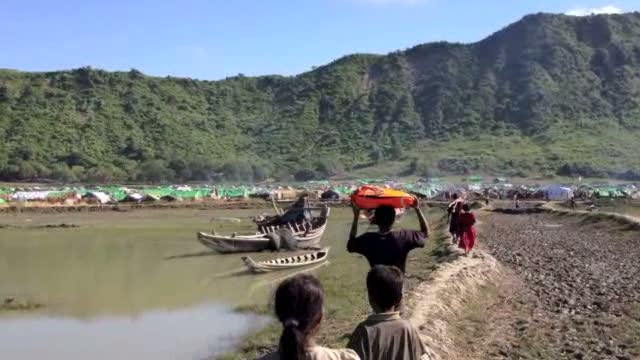More than one month after Cyclone Komen, some impacted people remain homeless
News Stories, 21 September 2015
PONNAGYUN, Myanmar, Sept 21 (UNHCR) – More than one month on from the collapse of their home in Myanmar's western Rakhine State, Ma Nge and her 10-year-old son remain homeless. The strong winds created by Cyclone Komen had felled a nearby palm tree, causing it to fall directly onto the frail, thatched structure.
Standing in front of the fragments of their former home, still a jumble of broken bamboo and palm leaves, Ma Nge told UNHCR that they had been fortunate: "We were in the house when I saw that the tree was swinging in the wind. It didn't seem safe, so we decided to leave immediately and seek shelter with my sister-in-law next door. Three minutes later, the tree fell."
Ma Nge and her son, who live in a small village in Ponnagyun township some 20 miles north-east of the state capital Sittwe, are just two of the many people who have been critically affected by the severe weather which hit the region in July.
Before making landfall in neighbouring Bangladesh on July 30, Cyclone Komen had swept past western Myanmar, causing high winds and heavy rains throughout the country and increasing the severity of the seasonal downpours. Over the following days and weeks, 12 of the 14 states and regions in Myanmar experienced major flooding. Rakhine and Chin states, as well as Magway and Sagaing regions, were declared as "natural disaster zones" by the Myanmar Government.
According to Myanmar's National Natural Disaster Management Committee, the stormy conditions and rising floodwater forced approximately 1.6 million to leave their homes during July and August. At least 117 people have been killed. Some 800,000 acres of farmland have been destroyed, posing risks to the country's food security.
Rakhine and the northern state of Kachin are home to an existing population of 240,000 internally displaced people, many of whom were also impacted. Leveraging its presence in the two states, UNHCR has been able to respond quickly in flood-affected communities, both displaced and non-displaced. Together with partner organisations and in coordination with the Myanmar authorities, UNHCR helped to assess the damage, identify needs and provide relief.
Emergency relief items – including tarpaulins, sleeping mats, mosquito nets and cooking utensils – were distributed to those affected based on need. UNHCR also led protection-driven advocacy with humanitarian partners and the Government; this focused on calling for freedom of movement as a life-saving measure and access without discrimination, in particular for vulnerable groups. Ma Nge and her son were among the recipients of UNHCR assistance.
"Everything we had was destroyed," she said. "All our household items are gone," Ma Nge intends to rebuild her house after the rainy season, but acknowledged the financial hurdles. Her husband moved to Thailand nine years ago to find employment. She is not sure what he is currently doing. "I think his work is not going so well," she explained.
On top of suffering from a displacement situation arising from the bouts of inter-communal violence in 2012, Rakhine State is the second poorest in all of Myanmar. Many of the families affected by the floods, especially female-headed households, were already at risk. Despite its wealth of natural resources, communities throughout the state are marked by chronic poverty and under-development. Poor infrastructure and basic services, coupled with limited livelihood opportunities have led many to leave in search of jobs elsewhere – within Myanmar and outside the country.
"As the focus of the response shifts from emergency assistance to recovery and rehabilitation, the urgent needs throughout Rakhine State need to be addressed," said Giuseppe de Vincentiis, UNHCR Representative in Myanmar. Among the ongoing challenges are ending displacement and advancing social cohesion between and within communities.
"It is crucial to ensure that the post-floods response is a holistic one that facilitates the sustained, community-based development of Rakhine State in its entirety, from south to north. And it is crucial that it's done now."
By Kasita Rochanakorn in Ponnagyun, Myanmar









































































